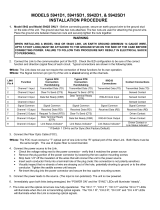8. Disturbance recorder
The IED is provided with a disturbance recorder
featuring up to 12 analog and 64 binary signal
channels. The analog channels can be set to
record either the waveform or the trend of the
currents and voltage measured.
The analog channels can be set to trigger the
recording function when the measured value falls
below or exceeds the set values. The binary
signal channels can be set to start a recording on
the rising or the falling edge of the binary signal or
both.
By default, the binary channels are set to record
external or internal IED signals, for example the
start or trip signals of the IED stages, or external
blocking or control signals. Binary IED signals
such as a protection start or trip signal, or an
external IED control signal over a binary input can
be set to trigger the recording. The recorded
information is stored in a non-volatile memory and
can be uploaded for subsequent fault analysis.
9. Event log
To collect sequence-of-events (SoE) information,
the IED incorporates a non-volatile memory with a
capacity of storing 1024 events with associated
time stamps. The non-volatile memory retains its
data also in case the IED temporarily loses its
auxiliary supply. The event log facilitates detailed
pre- and post-fault analyses of feeder faults and
disturbances. The increased capacity to process
and store data and events in the IED offers
prerequisites to support the growing information
demand of future network configurations.
The SoE information can be accessed locally via
the user interface on the IED front panel or
remotely via the communication interface of the
IED. The information can further be accessed,
either locally or remotely, using the web-browser
based user interface.
10. Recorded data
The IED has the capacity to store the records of
128 latest fault events. The records enable the
user to analyze the power system events. Each
record includes the phase, differential and bias
current values, time stamp, etc. The fault
recording can be triggered by the start signal or
the trip signal of a protection block, or by both.
The available measurement modes include DFT,
RMS and peak-to-peak. In addition, the maximum
demand current with time stamp is separately
recorded. By default, the records are stored in a
non-volatile memory.
11. Condition monitoring
The condition monitoring functions of the IED
constantly monitors the performance and the
condition of the circuit breaker. The monitoring
comprises the spring charging time, SF6 gas
pressure, the travel-time and the inactivity time of
the circuit breaker.
The monitoring functions provide operational
circuit breaker history data, which can be used for
scheduling preventive circuit breaker maintenance.
12. Trip-circuit supervision
The trip-circuit supervision continuously monitors
the availability and operability of the trip circuit. It
provides open-circuit monitoring both when the
circuit breaker is in its closed and in its open
position. It also detects loss of circuit-breaker
control voltage.
13. Self-supervision
The IED’s built-in self-supervision system
continuously monitors the state of the IED
hardware and the operation of the IED software.
Any fault or malfunction detected is used for
alerting the operator.
A permanent IED fault will block the protection
functions to prevent incorrect operation.
14. Current circuit supervision
The IED includes current circuit supervision.
Current circuit supervision is used for detecting
faults in the current transformer secondary
circuits. On detecting of a fault the current circuit
supervision function activates an alarm LED and
blocks the line differential protection and negative
sequence overcurrent protection functions to
avoid unintended operation. The current circuit
supervision function calculates the sum of the
phase currents from the protection cores and
compares the sum with the measured single
reference current from a core balance current
transformer or from separate cores in the phase
current transformers
Line Differential Protection and Control
1MRS756500 F
RED615
Product version: 4.0
ABB 17





















